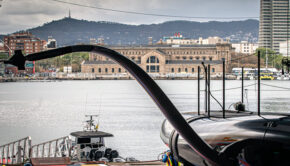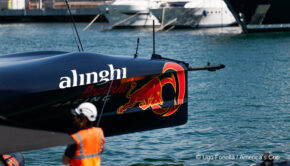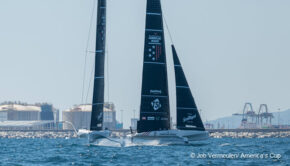How dominant was America in 1851?
Published on March 13th, 2019
Bengt O. Hult, now at 96 years old, is a retired International Judge who had served the sport throughout the world. He is also the author, or translator, of more than 50 books, mostly on sailing, and has lectured on racing rules for decades.
The Swede is also a keen observer of America’s Cup history, and in this report takes issue with the interpretation of the – “there is no second, Your Majesty” – statement.
I seek to share the true story of the race around the Isle of Wight in 1851 which is often, incorrectly, called the first race for the America’s Cup.
I have read with interest a number of articles about the history of that famous race in England in 1851 which have generally just repeated the old story as told by the owners of America. Among other things, the remark of that silly footman aboard the Queens paddle steamer – “there is no second, Your Majesty” –indicating that the yacht was a flyer.
People have for more than 150 years deliberately misinterpreted that remark. What is reported is not at all what he meant. I think it is time to sort out what actually happened that day. The following facts are taken from the press and other sources from that time. So off we go…
It is normally reported that there were 15 yachts – 7 schooners and 8 cutters – entered and starting in the race round the Isle of Wight. There was, in fact, one more entered, the Irish sandbagger or, as they were called in Europe, beach yawl, called Wildfire.
However, the haughty officers of Royal Yacht Squadron did not like that type of boat although it was an established type in the US at that time. They refused her entry, but that did not stop her from starting in the race together with the other smaller yachts.
After having sailed for about one hour the yachts should take the Nab light vessel to starboard, some miles off the coast. Most yachts did so but America followed the coast and fell off, thereby gaining some miles.
The other yachts protested of course but the race committee explained that they had given the guests a special, very elegant copy of the sailing instructions where the Nab by mistake was left out in the course diagram. They could not be blamed for following that diagram so the protest was dismissed.
It is not quite clear but it seems that some other yachts followed in the wake of America, among them Wildfire. An hour later two other cutters, Volante and Frank, had worked closer to the shore south of the island and were then in the lead. This is confirmed in the log of America. The wind was light and the tide against.
Now America put in a number of tacks to get close to the shore as well. The reason was to cheat the tide. Other yachts followed, and soon a number of yachts were fighting hard for free wind. Frank tacked in front of Volante and broke her bowsprit.
When the yachts rounded St Catherine’s Point – half way round the island – Aurora was close behind America but first of them all was Wildfire. Her lead was substantial, three miles. This was confirmed by Montague Guest, the official historian of the club, who wrote about the race in 1902.
When they later could ease the sheets, America managed to catch up with Wildfire near the Needles, the formidable rock pillars outside the western point of the island. The wind was again dying and, what was even worse, the tide had changed and was now against.
America had now goose-winged her two big sails in order to catch as much wind as possible and chose to get out into the Solent. In contrast, the smaller yachts tried to get as close to the coast as possible to cheat the tide. In fact, they even went in to bays and nooks as there was no tide there at all.
Finally America managed to cross the finish line, which was when that footman told the Queen aboard the royal paddle steamer that America was first but there was no second. Where were all the others then? They could not have sunk all of them and they could not possibly be below the horizon. The truth is, of course, that they were inside a nook and obscured by a headland.
The official results show that the second yacht, Aurora, was only 8 minutes behind. She had a very high peaked gaff, making the rig more like a gunter rig. If it is a formidable achievement that America (30.86 meters and 132 ton) beat Aurora (19 meters and 47 ton) by 8 minutes after having sailed 54 miles in about 10 hours is up to the reader to decide, especially as America cut the course at the Nab and Aurora did not.
While Wildfire was not in the official results, the press reported that she was a few miles in front of the winner when she finished.
Perhaps the winners themselves can give us their appreciation of the yacht America. They sold the yacht as soon as they could, grabbed the cup and the money and went home to New York. Did they brag about their feat? No, they put the cup in a cupboard where it stayed for seven years before they took it out, renamed it America’s Cup, and donated it to NYYC.
What about the new British owner, lord John de Blaquiere, then? Did he use his “golden egg” to win numerous matches? No, he entered her in a few matches, won some and lost some.
One match in 1852 was against the Swedish schooner Sverige of the same size. They raced east of the island, and at the turning point the Swedish yacht had a lead of nearly nine minutes. However, on the way to the finish, her main gaff broke so that the sail could not be sheeted in, giving America one of her few victories.
Anyone may have an opinion of America. After having read this true story, you as a reader may have yours.









 We’ll keep your information safe.
We’ll keep your information safe.